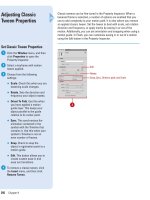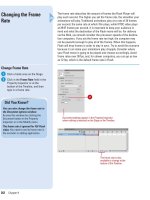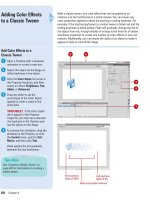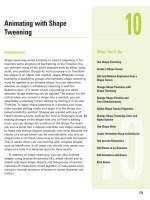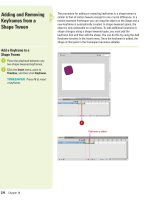Tài liệu Thiết kế flash với flash cs5 part 2 ppt
Bạn đang xem bản rút gọn của tài liệu. Xem và tải ngay bản đầy đủ của tài liệu tại đây (1 MB, 10 trang )
ptg
Chapter 1 Getting Started with Flash CS5
11
buttons, arrows, or other navigation elements
that move the viewer to different parts of a
movie or to different locations on the Web.
After you add a component, you can use
behaviors to add functionality to the compo-
nent to make it do what you want. In addition
to behaviors, you can use built-in Timeline
effects to add motion to elements. As you
build in movie navigation and organization,
it’s good design to break up large projects
into smaller movies, which can be quickly
accessed from a main movie. This keeps
Internet download times to a minimum, and it
makes projects easier to update, and more
manageable for a team to produce.
Step 5: Preview and test the movie
After you create your project, you use one of
the Test Movie commands to preview and test
the movie to make sure it runs the way you
want it to. It's important to test the functional-
ity of your movie early and often during the
development process to catch problems while
they are still minor.
Step 6: Publish the document as a movie
file for use over the Internet
When the movie runs the way you want it to,
you can publish your production as a Flash
movie that viewers can play on a Web page,
using a browser with the Flash Player. Flash
publishes the movie file (.swf) and creates an
HTML file with information to display the
movie file. Viewers can't change the movies in
the SWF format; they can only play them.
Step 2: Create
or import
media
elements
Step 4: Add navigational components,
interactive behaviors, and motion effects
Step 1: Setup
document
properties
Step 6: Publish the
document as a
movie
Step 5: Preview and test the movie
Step 3: Position the elements on the Stage
and sequence them in the Timeline
From the Library of Wow! eBook
ptg
12
Chapter 1
A file in Flash is called a document. Flash documents, which have the
FLA filename extension, contain all the information required to develop,
design, and test interactive content. Flash documents are not the same
as the movies you play with the Flash Player. Instead, you publish your
Flash documents as Flash movies, which have the SWF filename exten-
sion and contain only the information needed to display the movie. A
new Flash document is based on the scripting language you want to
use, either ActionScript 2.0 or ActionScript 3.0. You can create new doc-
uments in several ways including using the New command on the File
menu and the New Document task pane. When you open a new Flash
document, it’s blank, ready for you to create or insert text, graphics, and
other media content. By default, the first Flash document is titled
Untitled1. Flash numbers new documents consecutively. You can open
and work on as many new documents as you have memory (RAM) for.
Creating a New
Document
Create a New Blank Document
Click the File menu, and then
click New.
TIMESAVER
Click Flash
Document on the Welcome screen
to create a new blank document.
Click the General tab.
Click ActionScript 3.0 or
ActionScript 2.0.
IMPORTANT
ActionScript 2.0
and ActionScript 3.0 are not
compatible with each other.
ActionScript 3.0 is recommended.
◆
If you want to create a specific
type of document, click the type
you want.
Click OK.
4
3
2
1
2
3
4
Did You Know?
You can open a new window with a
copy of the current document.
Create
or open the Flash document you want
to open in a new window, click the
Window menu, and then click
Duplicate Window.
Creating New Documents for Other Purposes
In addition to creating FLA documents in ActionScript 2.0 or 3.0 for
the Flash Player, you can also create FLA documents to publish
applications for Adobe AIR 2.0 (for Mac, Windows, and Linux),
iPhone OS (for iPhone, iTouch, and iPad devices)
(
New!
)
, Flash Lite
4 (a Flash player for less power and memory-constraint devices),
and Adobe Device Central (for mobile devices).
For Your Information
Documents with the FLA extension
Document with other extensions
From the Library of Wow! eBook
ptg
Chapter 1 Getting Started with Flash CS5
13
Creating a New
Document from a
Template
Create a New Document from a
Template
Click the File menu, and then
click New.
TIMESAVER
Click a template
category on the Welcome screen
to open the New From Template
dialog box, where you can select
a template.
Click the Templates tab.
Click a template category.
Click the template you want to
use.
View the templates in the Preview
box and read the description.
Click OK.
6
5
4
3
2
1
Flash makes it easy to create many common documents based on a
template. A template opens a Flash document (such as an animation or
set of menus) with predefined formatting and placeholder text, graph-
ics, and actionscripts. The templates make it easy to create common
types of Flash projects. Flash comes with a set of templates, which
includes the following categories (
New!
): Advertising, Animation,
Banners, Media Playback, Presentations, and Sample Files. When you
select a template category, a list of templates appears. Select a tem-
plate to display a brief description. If you can’t find the template you
want, you can check the Adobe Flash Support Center Online Web site
for more.
5
2
4 6
3
See Also
See “Saving a Document in Different
Formats” on page 22 for information on
saving a document as a template.
From the Library of Wow! eBook
ptg
14
Chapter 1
You can open an existing document file and the Flash program at one
time, or you can open the file from within Flash. In Flash, you can use
the Welcome screen, Open commands on the File menu, or Adobe
Bridge CS5 (a stand-alone file management program that comes with
Flash CS5) to open Flash documents, scripts, and movies in several for-
mats. The default file format for Flash is FLA. However, the internal for-
mat of an FLA file is XFL (eXtensible Form Language) (
New!
). XFL
allows you to exchange file content between programs, such as Adobe
InDesign and Adobe After Effects. You can also open an XFL file as you
would an FLA file. When you open a document, a tab appears across
the top of the Document window, which you can click to display it.
Opening an
Existing Document
Open a Flash Document
Click the File menu, and then click
Open.
TIMESAVER
Click Open or a
recently opened Flash document
name on the Welcome screen to
open a document.
To open a specific type of Flash
file, click the File as type list arrow
(Win), or the File type popup
(Mac), and then select the file
format you want.
Navigate to the drive or folder
where the file is located.
Click the document file you want
to open.
Click Open.
5
4
3
2
1
3 5
2
Did You Know?
You can view what is inside of an XFL
file.
An XFL file is essentially a ZIP
package containing the XML and the
assets for a FLA file. To view the actual
XML and assets of the FLA file, change
the .XFL file extension to .ZIP and unzip
the folder.
Format Description
ActionScript (.as) A file to store ActionScript code for a
Flash document.
XFL (.xfl, .xml)
A packaged XML representation of a FLA
file along with the assets for that file.
Communications (.asc) A file to store ActionScript code on a
computer with Flash Communication Server.
FLA Document (.fla) A Flash document you create and save
in Flash authoring environment.
JavaScript (.jsfl) A separate file with JavaScript code to add
new functionality to Flash.
Flash Movie (.swf) A compressed movie file you publish in the
Flash authoring environment.
Other Dynamics
From the Library of Wow! eBook
ptg
Chapter 1 Getting Started with Flash CS5
15
Open a Recently Opened
Document
Click the File menu, and then point
to Open Recent.
Click the document you want to
open.
Browse Documents in
Adobe Bridge
Click the File menu, and then click
Browse in Bridge.
Adobe Bridge CS5 opens,
displaying files and folder on your
computer.
Select a workspace display to
view your files the way you want.
Navigate to the drive or folder
where the Flash file is located.
To open a Flash file, double-click
the file icon.
When you’re done, click the File
menu, and then click Return to
Adobe Flash.
TIMESAVER
Press
A
+Option
(Mac) or Ctrl+Alt+O (Win).
5
4
3
2
1
2
1
1
2
Did You Know?
You can open a recent file quickly
from the Start menu (Win).
Click the
Start button, point to Adobe Flash
Professional CS5 (7), Recent Items
(Vista) or My Recent Documents (XP),
and then click the file name you want
to open.
4
5 3 2
From the Library of Wow! eBook




